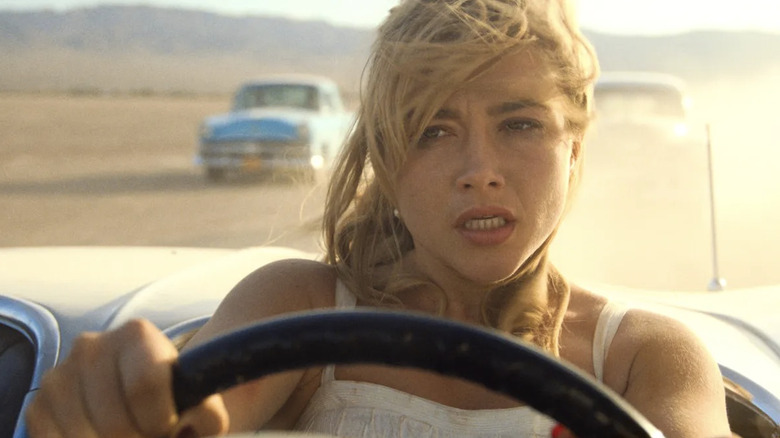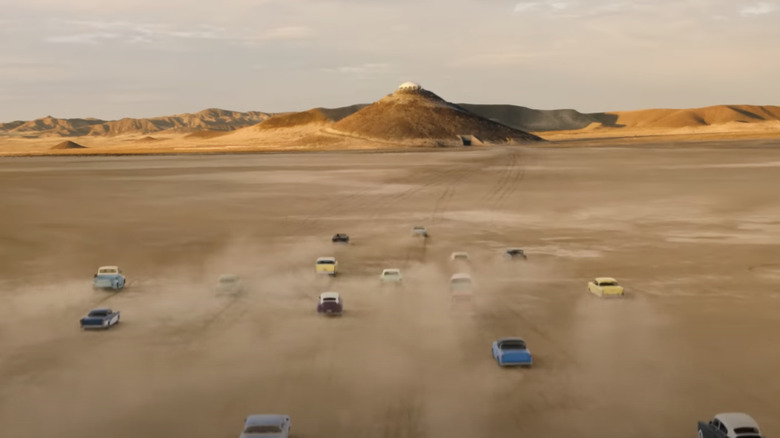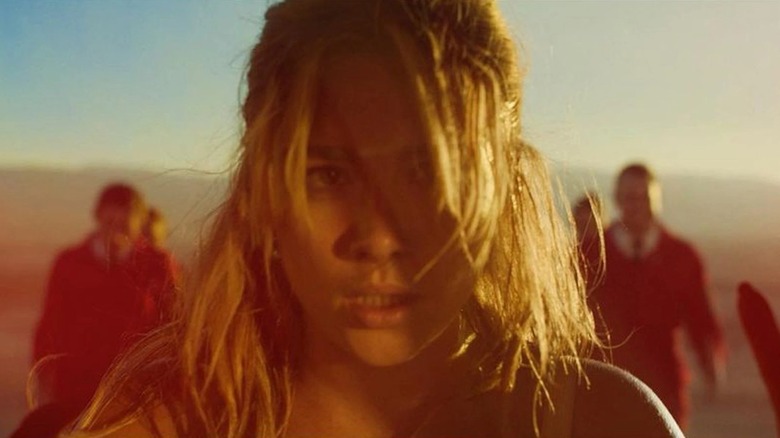Why Don't Worry Darling's Action-Packed Ending Was So Challenging To Shoot [Exclusive]
Olivia Wilde's newest film "Don't Worry Darling," which opens in theaters today, is a genre shifting, mystery box piece of popcorn entertainment. Like with most directors who have seen a lot of success with their popular debuts, Wilde (whose first feature, "Booksmart," earned overwhelmingly positive reviews) admirably swings for the fences with a larger scope, bigger ideas, and just the right amount of confidence in her sophomore film.
We spoke to cinematographer Matthew Libatique (whose credits include "Black Swan," "A Star Is Born," and Darren Aronofsky's "The Whale") about how he brought the sexy, sun drenched and sinister vibe of the Victory Project to life. Shot in Palm Springs, "Don't Worry Darling" creates an intoxicating 1950s aesthetic with an underlying surrealness, reflecting the protagonist Alice (Florence Pugh) and the slow decay of her reality.
Even for someone as experienced as Libatique, there's always something to learn on every film set. He cites an action sequence in climax of "Don't Worry Darling," as a particularly challenging experience.
If you haven't seen "Don't Worry Darling" yet, be warned: there are spoilers ahead!
Matthew Libatique stood up to the challenge of shooting action
The last fifteen minutes of "Don't Worry Darling" is when the danger for Alice starts to set in. After discovering she was stripped of her agency to live in a simulated "paradise," her pattern of rebellious behavior has made her a fugitive within the Victory community. With the encouragement of her friend Bunny (Olivia Wilde), Alice decides to make a run for it.
If only it were only that easy. The only way to escape the simulation is to reach a beacon in the middle of the desert. When Alice decides to commandeer her husband Jack's (Harry Styles) Corvette, a classic, cinematic car chase ensues. Since the first two acts of the film stay mostly in psychological thriller territory, this is a big shift in tone. According to Libatique, there was actually no second unit director on set, a role that would normally handle action-sequences such as these. This left Wilde and Libatique to collaborate and research how to accomplish this scene together.
"She was so excited about shooting this sequence and as a cinematographer, I didn't want it to fail ... I'm not a second unit director, and Olivia isn't really an action director either, but we did our due diligence. We did the research. We just compiled a bunch of sequences and started to pick apart things that we liked. That was the biggest, not hurdle, but was the biggest concern for me. It's like, okay, so many times you just don't want the third act disappointing on a film. It's meant to keep people in their seats and have them eating the last bit of popcorn. We just wanted to make sure that we would service that. I think it does."
Don't Worry Darling's love for cinema shows
Wilde wears her influences on her sleeve in "Don't Worry Darling." From "The Stepford Wives," to "The Truman Show," and even "The Village," her tastes inform the film's intoxicating aesthetic with strong reverence to different eras of cinema. This is true for the car chase sequence as well; Wilde and Libatique worked together to cherry pick qualities of other chases in film that they felt stood out, and storyboarded the chase from there. As one of the last things they shot throughout the film's production, the approaching shoot was a lingering source of anxiety for Libatique:
"I'm proud of that sequence, but that was the most anxiety I had about the film. We worked on the sequence as we were shooting because of course, when we started shooting, we weren't ready to shoot that sequence. Luckily, we shot at the end of the schedule, but we storyboarded it. Then the budget had to cut it back and then had to rework sequences. And so, we just kept working on it and working on it, knowing when we both had the same goal, she said to me, 'I just want a badass action sequence.' That's a good direction."
Whether or not "Don't Worry Darling" succeeds in its bold genre shifts and tributes to cinema history is up to you. Although the reception to the film has been quite mixed, one thing critics seem to agree on is that the film's visual style is rich, gorgeous, and full of life. If Libatique can take on something so thrilling as a high speed, desert car chase based on research and faith, it's exciting to think about what he will do next.
"Don't Worry Darling" is in theaters now.


